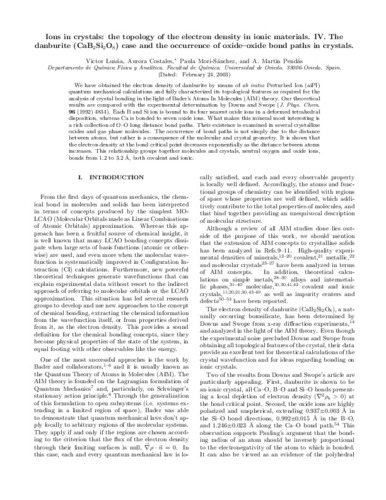Ions in crystals: the topology of the electron density in ionic materials. IV. The danburite (CaB2Si2O8) case and the occurrence of oxide-oxide bond paths in crystals.
Autor(es) y otros:
Palabra(s) clave:
Chemical Bond
crystals
topology
Fecha de publicación:
Versión del editor:
Citación:
Descripción física:
Resumen:
We have obtained the electron density of danburite by means of ab initio Perturbed Ion (aiPI) quantum mechanical calculations and fully characterized its topological features, as required for the analysis of crystal bonding in the light of Bader’s atoms in molecules (AIM) theory. Our theoretical results are compared with the experimental determination by Downs and Swope (J. Phys. Chem. 1992, 96, 4834). Each B and Si ion is bound to its four nearest oxide ions in a deformed tetrahedral disposition, whereas Ca is bonded to seven oxide ions. What makes this mineral most interesting is a rich collection of O-O long-distance bond paths. Their existence is examined in several crystalline oxides and gas phase molecules. The occurrence of bond paths is not simply due to the distance between atoms but rather is a consequence of the molecular and crystal geometry. It is shown that the electron density at the bond critical point decreases exponentially as the distance between atoms increases. This relationship groups together molecules and crystals, neutral oxygen and oxide ions, with bonds from 1.2 to 3.2 Å, both covalent and ionic.
We have obtained the electron density of danburite by means of ab initio Perturbed Ion (aiPI) quantum mechanical calculations and fully characterized its topological features, as required for the analysis of crystal bonding in the light of Bader’s atoms in molecules (AIM) theory. Our theoretical results are compared with the experimental determination by Downs and Swope (J. Phys. Chem. 1992, 96, 4834). Each B and Si ion is bound to its four nearest oxide ions in a deformed tetrahedral disposition, whereas Ca is bonded to seven oxide ions. What makes this mineral most interesting is a rich collection of O-O long-distance bond paths. Their existence is examined in several crystalline oxides and gas phase molecules. The occurrence of bond paths is not simply due to the distance between atoms but rather is a consequence of the molecular and crystal geometry. It is shown that the electron density at the bond critical point decreases exponentially as the distance between atoms increases. This relationship groups together molecules and crystals, neutral oxygen and oxide ions, with bonds from 1.2 to 3.2 Å, both covalent and ionic.
ISSN:
DOI:
Patrocinado por:
We are grateful to the Spanish DGICyT, Grant BQU2000-0466, for financial support. A.C. thanks the Ministerio de Ciencia y Tecnología for her Ramón y Cajal fellowship. P.M.S. is now a Fulbright fellow at Duke University. Careful reading of the manuscript by L. Pueyo is gratefully acknowledged.
Colecciones
- Artículos [37321]
- Investigaciones y Documentos OpenAIRE [8282]
- Química Física y Analítica [633]
Ficheros en el ítem





